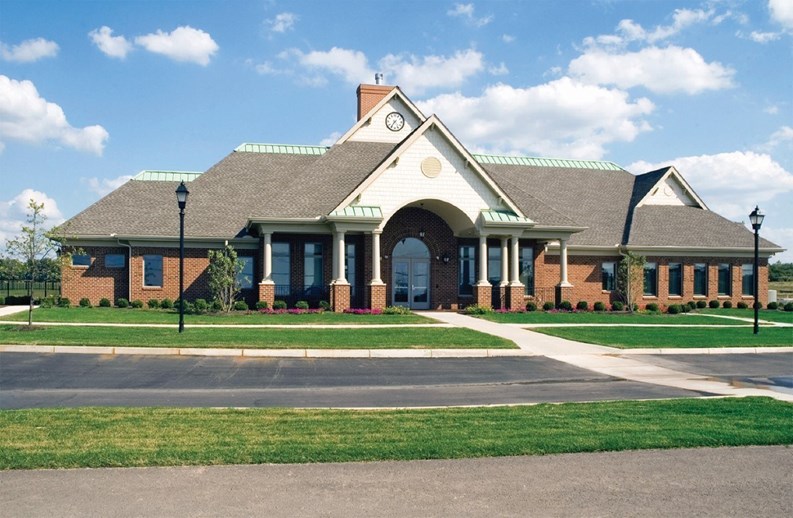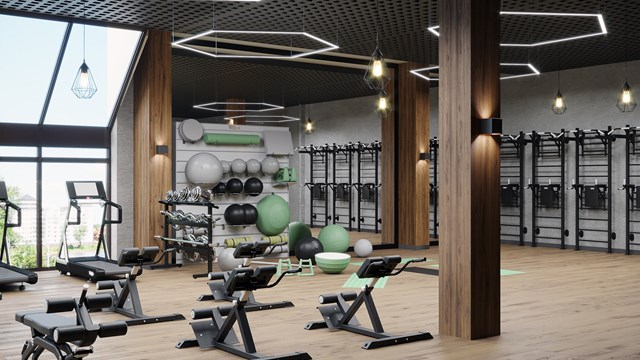Riding stables, tennis courts, boat slips—the recreational facilities at some communities are downright dazzling. At New Seabury on Cape Cod, seemingly endless stretches of beach, ponds and peninsulas are supplemented with restaurants, lodging, pool and fitness centers, a marina and cabana club—never mind two 18 hole golf courses. If piloting your own Cessna is your passion, there’s the Falmouth AirPark subdivision, also on Cape Cod, where homeowners share their own landing strip.
Prefer winter activities? A community under construction at Loon Mountain Ski Resort in New Hampshire will feature new ski lifts that load right in the residents’ common area. Even at the new urban Falls at Arden Mills, with 204 units planned in Fitchburg, Massachusetts, a clubhouse/fitness center with indoor pool—for year-round fun—was recently unveiled.
Residents who enjoy these amenities as part of their ownership may want to reserve or rent them for their own private events, whether it’s a wedding or a sales meeting.
Should a community’s recreational facilities be available to residents only? And if there’s a demand, what about offering these facilities to the general public, as a possible source of revenue?
Cashing In
Whether a community cashes in—or cashes out—seems to depend on the size of a development, the types of amenities and how they are delineated from the project’s beginning. When condo developers promote boat basinsand ski lifts as homeowner perks, they’re probably operated outside the control of a homeowners’ association.
In the majority of condo communities, however, clubhouse space is a standard, expected amenity. Associationsusually have control of this clubhouse or function space—and may exercise options. The most popular option, though, seems to be maintaining these amenities for residents only.
Bernie Gitlin, president of Global Insurance Network of Needham, Massachusetts, explains why associations may opt out of renting their common facilities. While function and recreation facilities “are mostly only for residents, I have seen some communities rent out to the general public,” he notes.
“This could get a condo association into the business of rental halls… which opens up another whole issue of bringing in liquor.” It’s a good idea, he warns, to first check with your insurance carrier.
Insurance companies for the association routinely supply coverage for fitness center, pools and function spaces. Sometimes when parties, classes or other events are held in a common area, outside vendors take on the responsibility, with their own insurance, licensing or permits. Gitlin cites a community where yoga classes were offered in the clubhouse, and theinstructor “had her own insurance, that covered her classes wherever they were held.”
This is similar, he adds, “to having an outside vendor operate a snack bar by the [community’s] pool. The vendor would have the appropriate insurance or permits. It’s not the association that’s in the business of food service.” He notes that associations can make some revenue from their facilities with vendor or user fees, but it’s only worth it “if you can control it,” he says.
The bottom line, in Gitlin’s opinion, is that “the board of directors or the management company must take a risk-management approach to facility rentals. If fees are charged, they should determine if it’s enough to cover costs… or pay for extra insurance. You should find out if your insurance policy alreadycovers” the use or activity that’s being planned.
“Extension of Living Room”
For most communities with clubhouse or function space, “these facilities serve as an extension of one’s living room,” observes attorney Henry Goodman, a principal in the Law Offices of Goodman & Shapiro, LLC, in Dedham, Massachusetts. “Residentsneed [common spaces] to entertain, and unit owners can reserve them, although most associations charge a security deposit up front.”
“If a community rents its facilities to non-residents, it becomes semi-public… and must now be ADA [Americans with Disabilities Act] compliant. Public accommodation may kick in ADA regulations for the entire development’scommon areas,” Goodman notes.
“Most communities have common areas that are under the control of the board of directors,” he adds, “and most [of them] do not allow outside use… for three major reasons. There’s that potential of having to comply with ADA regulations, and there’s the issue of wear and tear. The third reasonis increased liability of strangers and the effect on insurance premiums.”
Phillip Lambert, vice president at The Dartmouth Group, a management firm in Bedford, Massachusetts, reports, “none of the facilities are open to the public” at the communities that his company manages. As a typical example, he cites one Massachusetts development in his client list that was constructed in the mid-1990s with 300 units and includes a fitness center, pools and tennis courts. He says, “Rental of the clubhouse includes a minimal fee to cover costs of utilities and cleaning, and a security deposit that is returned” following inspection after the event. “A rental contract is signed by the unit owner or resident” who is held responsible. “These facilities,” he adds, “are not to be used as income… they’re strictly for residents’ use.”
Check with Attorney Before Renting
For any community considering renting the clubhouse or other amenities, Andrew Raynor, president of Shawmut Property Management of North Andover, Massachusetts, advises, “I’d have an attorney review the condodocs to make sure” the regulations allow it. It’s also important to “check with your insurance carrier.”
He also stresses that “at a minimum, you need some accountability.” His firm recommends, at least, taking a damage deposit up front. This may be in the form of a fee, or it may be partly or completely refundable. He points out that “the homeowner typically signs a form [indicating] that he or she is ultimately responsible” for any damages to the facility.
The issue is not that guests are out of control and abusing the clubhouse. “Mostly,” Raynor adds, “damage is inadvertent” and more akin to wear and tear, such as wine spilled on upholsteryor heel marks on the floor.
For a condo association to rent to non-residents—to the general public—is almost unheard-of, and it’s mainly an issue of insurance, Raynor notes. “Withmost insurance carriers, the standard, master insurance policy for the condo association doesn’t cover third-party uses” of the real estate. While some policies may include broader uses of the common areas, customized coverage can always be negotiated to address rentals of facilities to non-residents—but it could be costly.
Aside from insurance, he adds, “I’d have an attorney review the condo docs to make sure [third-party use] is allowed.”
While in larger communities that Shawmut oversees, management staff may administer facility rentals, in smaller properties, association board members or committee volunteers would cover those duties.
Raynor doesn’t see many condo boards charging fees as a means of revenue for the association as there just isn’t enough volume to make it worthwhile. “Even in a large community, the function facility might get booked for private events five or six times a year,” he says. “The ability to reserve the clubhouse or other commonareas therefore serves more as a perk for residents, than a money-maker.”
Outsiders Present Issues
Lou Gargiulo, CMCA, agrees. As president of Great North Property Management in Portsmouth, New Hampshire, he says, “It’s not at all advisable to rent [facilities] to third parties. Renting to outsiders presents a number of issues, from insurance and liability to accountability. A good number of the properties we manage do not allow outside use at all. Anyone considering it should check their condodocs first to see if [third party use] is even allowed. Some docs are very specific about how common facilities can be used. Board members have to determine if they have the right to act as rental agents.”
“If your condo docs do not address it [third party use] it’s usually understood that the property’s amenities are for residents only. Even for residents using the common facilities, a contract should be involved that includes specific guidelines, including how the facilities may be used, clean-up duties…and signed by the person responsible for the event.”
Condo boards should rely on their legal counsel to draft a contract that protects the association’s interests, he adds.
Membership for “Non-Residents”
In large communities that can include major amenities such as marina docks or golf courses, memberships for those uses may extend to non-residents. Operations of these recreational entities are usually conducted by professional management companies, while the residents’ association may have little orno control over them. They become amenities that aren’t actually part of the condo community.
At New Seabury, the golf complex includes fitness facilities and even lodging—about 20 condos are rented to the general public. And the Popponessit Inn is a major restaurant, bar and function area. None of these amenities have any connection with New Seabury’s residential neighborhoods. All 1,400 housing units, ranging from mansions to townhouses, come under a self-managed, “master” association called the Peninsula Council. Sub-level association boards and committees have formed to oversee various neighborhoods. Although the golf memberships and fitness centers are for residents only, they are managed by various arms of the development corporation. And the marina is a completely separate property that owns the land it’s on and is open to the public.
Even the new slopeside community at Loon Mountain, called South Peak at Loon, will offer entertainment and restaurant/lodging venues, but those facilities will be owned and operated under the hospitality arm of the developer, Centex Homes of Texas. The on-location ski lifts are in place by way of an operating agreement with the ski area.
So it’s no wonder that it is almost unheard-of for a condo association to rent its facilities to the general public. And in large communities where amenities are shared with outsiders, chances are there’s a separate owner orcorporation managing things. Board members have to determine if the business of rentals is really worth it.






Comments
Leave a Comment